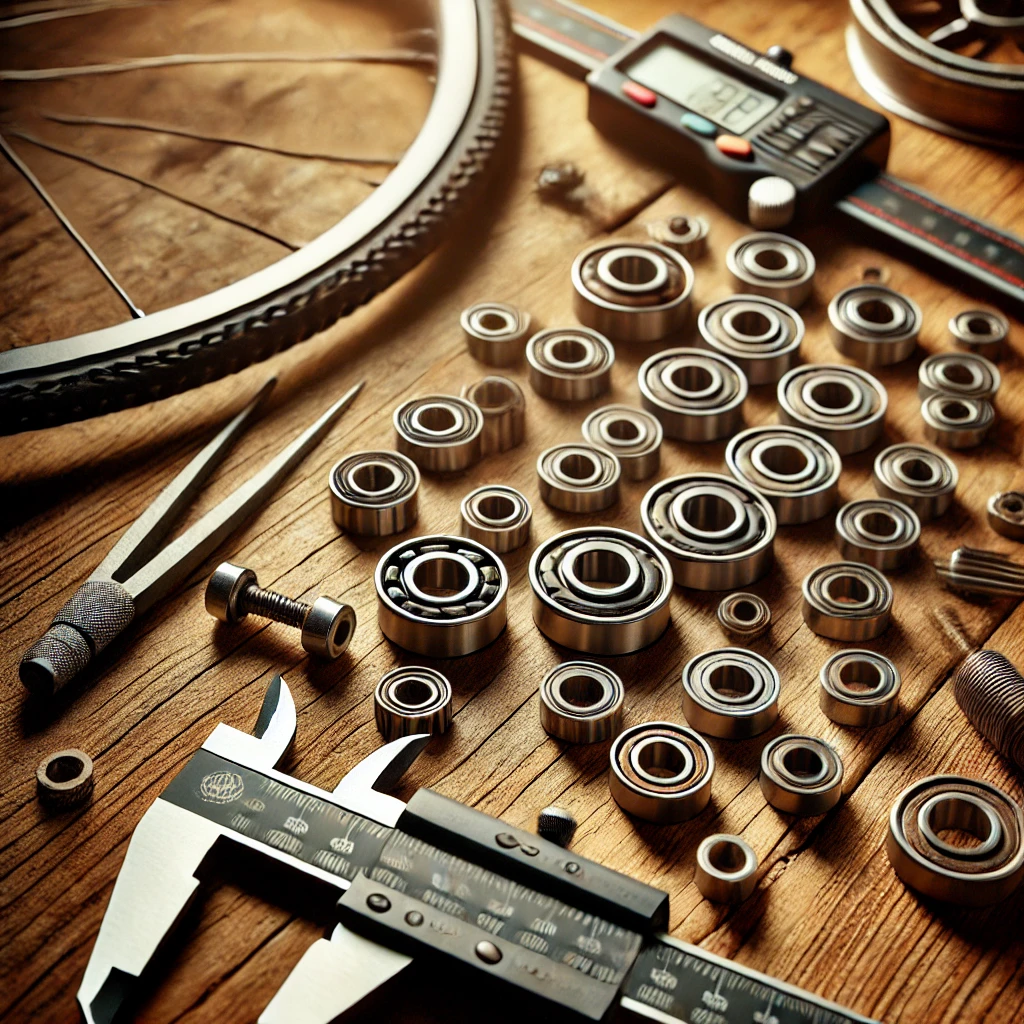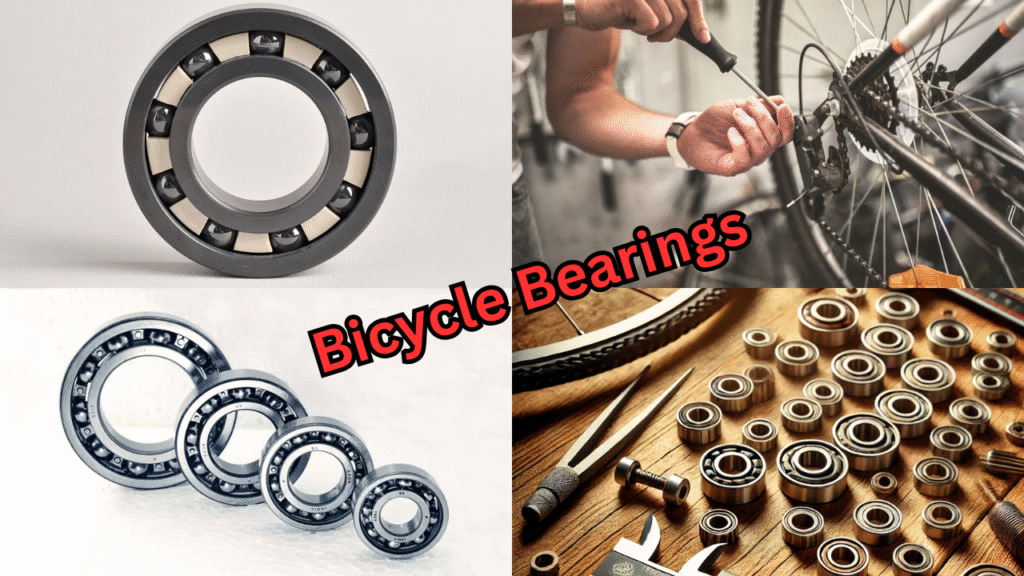
When you ride a bicycle, the smoothness of your pedaling and wheel movement depends on one small but very important component – the bearing. Bicycle bearings are the hidden heroes inside the hubs, bottom brackets, pedals, and headsets that make everything roll freely. Without them, cycling would feel rough, slow, and tiring. In this article, we will explore different types of bicycle bearings, their uses, sizes, and why ball bearings are also used in cars and other machines.
Types of Bicycle Bearings
There are several types of bearings used in bicycles. Let’s look at the most common ones:
- Loose Ball Bearings (Cup-and-Cone System)
- Steel balls sit inside a cup and are held by a cone-shaped nut.
- Found in older or budget bicycles.
- Advantages: Cheap, adjustable, easy to service.
- Disadvantages: Require frequent cleaning and greasing.
- Sealed Cartridge Bearings
- Pre-assembled units with inner race, outer race, balls, and seals.
- Used in modern hubs, headsets, and bottom brackets.
- Advantages: Long-lasting, low maintenance, resistant to dirt and water.
- Disadvantages: More expensive, cannot be serviced—only replaced.
- Ceramic Bearings
- Made of ceramic balls instead of steel.
- Advantages: Ultra-smooth, lightweight, corrosion-resistant.
- Disadvantages: Expensive, mostly for professional cyclists
Bicycle Ball Bearings

The most common type of bearings used in bicycles are ball bearings. These are tiny steel or ceramic balls placed inside a race (a circular groove) that helps reduce friction.
- How they work: When your wheel rotates, the balls roll inside the race, minimizing metal-to-metal contact. This reduces friction and makes pedaling smooth.
- Where they are used: Ball bearings are used in hubs (front and rear wheels), bottom brackets (pedal crank area), headsets (steering area), and pedals.
The advantage of ball bearings is that they are cheap, effective, and easy to replace when worn out.
Ball Bearings Are Used in bicycles cars etc because
You might wonder – why are ball bearings so popular in bicycles, cars, and even industrial machines? The answer is simple: they reduce friction and make movement efficient.
- Smooth Rotation: Bearings allow wheels and moving parts to spin with very little resistance.
- Durability: By reducing wear and tear, they increase the lifespan of components.
- Load Distribution: Bearings distribute the rider’s or vehicle’s weight evenly, preventing damage.
- Versatility: They work well in small machines (like bicycles) and heavy vehicles (like cars and trucks).
This is why ball bearings are considered one of the most important inventions in mechanical engineering.
Bicycle Ball Bearing Sizes

Bicycle ball bearings come in different sizes depending on where they are used. Common sizes include:
- 3/16 inch (used in front hubs and headsets)
- 1/4 inch (used in rear hubs and bottom brackets)
- 5/32 inch (used in pedals and some headsets)
The correct size matters because even a small difference can affect smoothness and wear. Many bicycles have loose ball bearings, while modern ones may use sealed cartridge bearings.
Bicycle Bearing Size Chart
Here’s a simple chart for reference:
| Bicycle Part | Common Ball Bearing Size |
|---|---|
| Front Hub | 3/16 inch (10 per side) |
| Rear Hub | 1/4 inch (9 per side) |
| Headset (Steering) | 5/32 inch (25–30 total) |
| Pedals | 5/32 inch (10–12 per side) |
| Bottom Bracket | 1/4 inch (9 per side) |
This chart can vary by brand and model, so always check your bike’s manual before buying replacements.
Ceramic Ball Bearings for Bicycles

In recent years, ceramic ball bearings have become popular in high-end bicycles. Unlike steel, ceramic balls are smoother, lighter, and harder.
Advantages of ceramic bearings:
- Less rolling resistance (faster speed with less effort)
- More durable and resistant to corrosion
- Lightweight, which is important for racing bikes
Disadvantage: They are expensive. Many professional cyclists and racers prefer them, but for casual riders, steel bearings are usually enough.
Bicycle Hub Cartridge Bearings
Traditional bicycles use loose ball bearings that need regular cleaning and greasing. Modern bikes, especially performance and mountain bikes, use sealed cartridge bearings.
- What are cartridge bearings?
They are pre-assembled units containing balls, inner race, outer race, and seals. - Advantages:
- Better protection from dirt and water
- Low maintenance (no need for frequent greasing)
- Easy to replace as a whole unit
Cartridge bearings are commonly used in wheel hubs, bottom brackets, and headsets of modern bicycles.
Bicycle Front Wheel Bearings
The front wheel hub of a bicycle houses bearings that allow the wheel to rotate smoothly around the axle.
- Loose bearings (older bikes): Use individual steel balls inside a cup-and-cone system.
- Sealed cartridge bearings (modern bikes): Provide smooth rolling and longer life.
If you feel wobbling or grinding while riding, it usually means your front wheel bearings need cleaning, greasing, or replacement.
Maintenance Tips for Bicycle Bearings

To keep your bearings running smoothly:
- Regular Cleaning: Dust, water, and mud can damage bearings. Clean them periodically.
- Greasing: Always apply fresh grease after cleaning.
- Check for Wear: If you hear grinding noise or feel roughness, replace the bearings.
- Upgrade if Needed: For racing or long-distance cycling, consider ceramic bearings.
Where Bearings Are Used in a Bicycle
Bearings are everywhere in a bicycle! Some key areas include:
- Wheel Hubs (Front & Rear): Allow wheels to spin smoothly around the axle.
- Bottom Bracket: Located at the center where the pedals rotate—critical for efficient pedaling.
- Headset: Connects the fork to the frame, allowing smooth steering.
- Pedals: Each pedal has bearings inside for smooth rotation under your foot.
Every time you turn your pedals, steer your handlebar, or coast downhill—bearings are silently doing their job.
Why Bicycle Bearings Matter

- Performance: Good bearings make your ride smoother and faster.
- Durability: They protect against wear and tear on expensive bike parts.
- Energy Efficiency: Less friction means you use less effort while riding.
- Comfort: Smooth steering and pedaling add to a better cycling experience.
Bicycle bearings may look small, but they have a big role in making your ride smooth, fast, and efficient. From steel ball bearings in everyday bikes to ceramic bearings in racing machines, the choice depends on your needs and budget. Whether it’s your front wheel hub, pedals, headset, or bottom bracket, keeping bearings clean and well-lubricated will ensure you enjoy cycling without extra effort. In short, bearings are the silent champions of bicycles and many machines around us.


